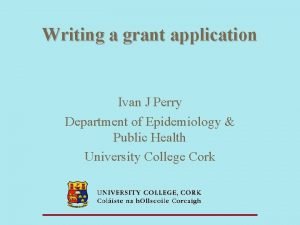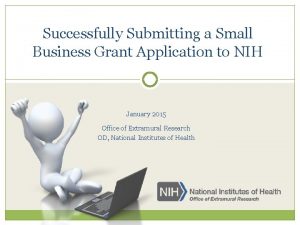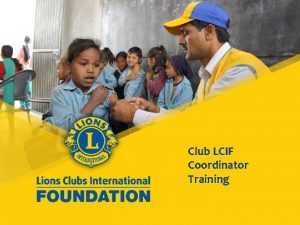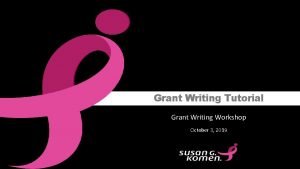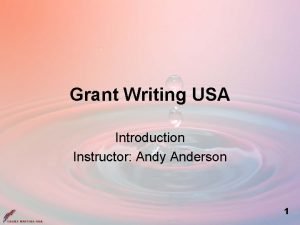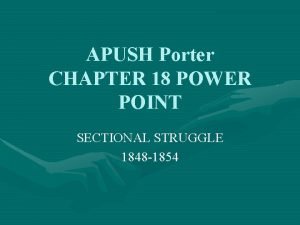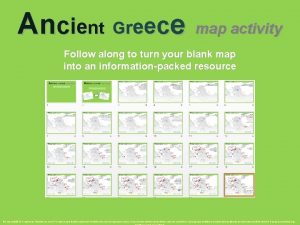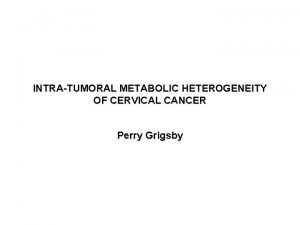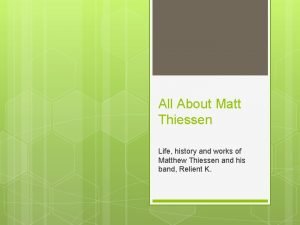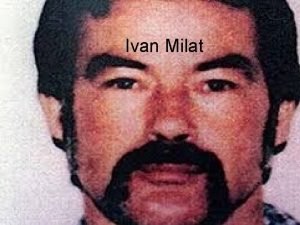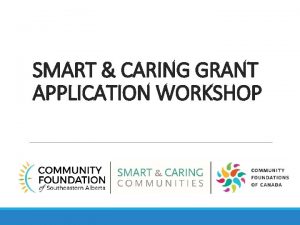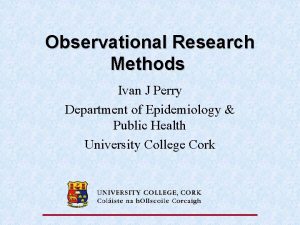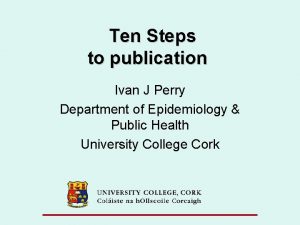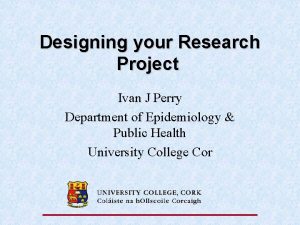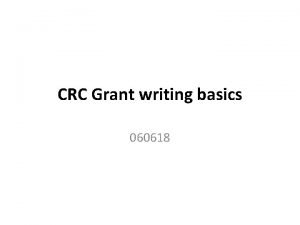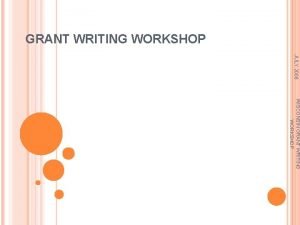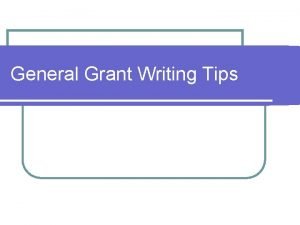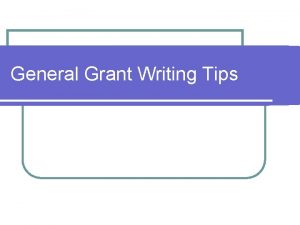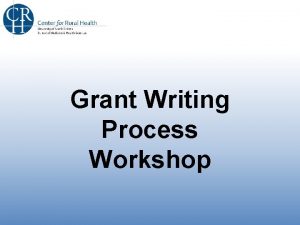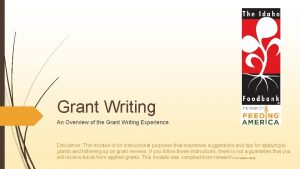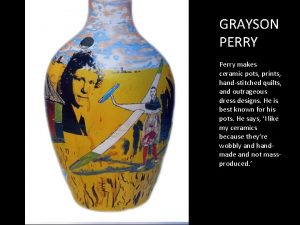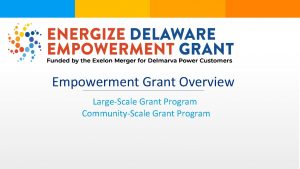Writing a grant application Ivan J Perry Department
































- Slides: 32

Writing a grant application Ivan J Perry Department of Epidemiology & Public Health University College Cork

Learning objectives w. Understand that writing research grant application for peer reviewed funding agencies is largely a technical skill that requires formal training and practice w. Be aware of resources available to support you in writing grant applications and understand the need to use these resources w. Be able to list the key elements to be addressed in submitting a research grant application for peer reviewed funding

Learning objectives w. Be able to list the major criteria used by funding agencies and grant committees in allocating research funds. w. Be able to list the most common reasons for failure to secure research funding. w. Understand the need to edit all sections of the grant application carefully to remove repetition and redundant material and ensure that each paragraph advances your argument.

Generic funding criteria w w w w Novelty/ originality Timeliness Clarity, coherence and feasibility of proposal Background of investigators/ appropriate research team Preliminary data Importance of topic Clinical/practical relevance of proposal/ actual or potential Value for money

Dog show rather than dog fight w Significance: ability of the project to improve health w Approach: feasibility of your methods and appropriateness of the budget w Innovation: originality of your approach w Investigator: training and experience of investigators w Environment: suitability of facilities and adequacy of support from your institution

Most common reasons for failure w w Problem not important enough. Study not likely to produce useful information. Studies based on a shaky hypothesis or data. Alternative hypotheses not considered. w Methods unsuited to the objective.

Most common reasons for failure Problem more complex than investigator appears to realize Not significant to health-related research. Too little detail in the research plan to convince reviewers the investigator knows what he or she is doing, i. e. , no recognition of potential problems and pitfalls. Issue is scientifically premature.

Most common reasons for failure Over-ambitious research plan with an unrealistically large amount of work. • Direction or sense of priority not clearly defined, i. e. , experiments do not follow from one another and lack a clear starting or finishing point. • Lack of focus in hypotheses, aims, and or research plan. • Lack of original or new ideas. • Investigator too inexperienced with the proposed techniques.

Most common reasons for failure w Proposed project a fishing expedition lacking solid scientific basis, i. e. , no basic scientific question being addressed. • Proposal driven by technology, i. e. , a method in search of a problem. • Rationale for experiments not provided, i. e. , why they are important or how they are relevant to the hypothesis. • Experiments too dependent on success of an initial proposed experiment. Lack of alternative methods in case the primary approach does not work out. • Proposed model system not appropriate to address the proposed questions. • Relevant controls not included.

Title It should be : Short Informative w indicate the broad area of research. w introduce the research question. w specify the research method to be used.

Title: example w HRB Project Grant Title: A randomised controlled cross over trial of the effect of modest salt restriction in the control of blood pressure in patients with type 2 diabetes mellitus.

The summary Should: – be a research protocol in miniature – give the key points only – not exceed the length or space allowed

Summary w It should introduce the topic explaining why more research is needed: 1 or 2 sentences w It should state the main aim of the research, expanding on the information given in the title: 1 sentence w Brief details of the study method should be presented including: the chosen research design, the nature of the study subjects, and the broad categories of data to be collected: 2 to 3 sentences w Finally it should indicate what the main findings may be and the implications which flow from these: 1 to 2 sentences

Background – The importance of the topic – A brief review of current research – The need for further research – The broad long term goals of proposed research

Aims w The aims of your study should be – briefly stated – seldom number more than four

Example w The aim of this study is to test the hypothesis that modest dietary salt restriction in patients with type 2 diabetes has a significant effect in lowering blood pressure, without a deleterious impact on metabolic control and insulin sensitivity. Specifically, we will measure the effect of a diet containing 5 grams of salt per day for 1 month on blood pressure, glycaemic control and insulin resistance, as compared to a diet containing 10 grams of salt per day for a similar time period. In a subsidiary open study, we will measure the effect of modest sodium restriction (5 grams of salt per day) for 7 months on the study end-points

Plan w The Plan of the Study should – – – give an overview specify the study design define the study subjects/patients describe how the data will be collected outline the study procedures describe briefly the statistical analysis.

Statistical Methods w A limited description is needed of the statistical techniques which will be used. It is usually sufficient to mention a few techniques, such as Chi-squared tests, Analysis of Variance, multiple regression, logistic regression, etc. w The appropriate statistical techniques are usually clear from the study design and the specification of the data to be collected.

Example w Data management and analysis: All data will be recorded on standard clinical report forms and will be entered in duplicate onto an Epi. Info database. Data checking and analysis will take place in the Department of Epidemiology & Public Health using SPSS for Windows. All analyses will be based on intention to treat. The principal analysis will consist of paired T tests comparing the differences in the major study end points during the two crossover phases of the study. Paired T tests will also be used to compare differences in blood pressure, glycemic control and insulin resistance between recruitment and the end of the Open phase of the study

Sample size w Formal sample size calculations are required for all research studies w These indicate how many study subjects are needed so that, if the research ideas are correct, it is very likely that a statistically significant result will be obtained. w If the study is too small a real effect may be overlooked. If it is too large, resources will be wasted.

Example w Sample size and study power: A total of 120 patients will be recruited for this study. This will be the largest cross-over trial of the effect of sodium restriction on blood pressure conducted to-date. The study will have 80% power to detect a mean difference in systolic blood pressure during the two crossover phases of the study of 6 mm. Hg at the 5% significance level, assuming a standard deviation of paired response differences of 14 mm. Hg. Given the number of participants and the cross over design the study will also have considerable power to address effects of moderate sodium restriction on metabolic control. The latter cannot be estimated precisely due to the lack of data from previous studies.

Purpose and Potential w Generally not self-evident that your topic is crucial and needs funding w Essential to demonstrate that your project should have high priority w Explain what the results will do for patient care, or how they will improve it, or save money. w Clarify the extent to which the potential implications of your work are not limited to the narrow confines of the project, but will carry across to much wider areas of health care.

Example IMPORTANCE OF THE PROPOSED STUDY: Successful completion of this study will provide internationally generalisable data on the role of modest sodium restriction in the management of blood pressure in patients with type 2 diabetes. The findings will have important implications for clinical practice and public health policy development with regard to food and health.

Timetable and Milestones w The timetable should explain what activities will take place at specified times during the study. w May be helpful to use a project management chart to illustrate the timing of activities, particularly if they overlap each other in time. w Be sure that the timetable fits exactly with the funding requested.

Example w Study timetable: The estimated duration of the project is 3 years. Standardisation of procedures, training and the pilot project will take approximately 3 months. We anticipate that successful recruitment, randomisation and completion of one year follow-up on 120 patients of patients will take place over 24 months. Data preparation and analysis and the drafting of manuscripts for publication will take between 6 to 9 months.

Existing facilities w Funding bodies like to feel that they are getting good value for money, an impression fostered if some of the facilities are provided by the applicants. w Spell out the inputs to the project (staff time, facilities and other resources that the grant giving body is not asked to fund, e. g. no funding is required for the Principal Investigator, for I. T support…

Financial Plan w Staff salaries (check established scales, e. g. HRB or Wellcome Trust w Equipment (generally avoid asking for P. C. s !) w Consumables (do not underestimate) w Travel and subsistence

Justification of costs Key items for justification w Staff w Equipment w Travel and subsistence w Minor items

Ethics w Does the proposed research place the subjects under undue risk w Will subjects be fully informed about the nature of the study. w Are legislative requirements met, e. g. IMB approval for clinical trials w Send copy of ethical approval correspondence if available

Ethics: example w ETHICAL APPROVAL/ IRISH MEDICINES BOARD w The trial protocol will be submitted for ethical approval to the Clinical Research Ethics Committee of the Cork Teaching Hospitals in March 1999 and subsequently for Clinical Trial approval to the Irish Medicines Board (Category 3 b).

References w The Vancouver style for references is recommended as it is used by almost all medical journals. w Uses numbers in the text and lists the references in numerical order. w Minimises the space used for references in the plan, where space is at a premium.

Curriculum Vitae w The CV for each applicant should be brief and certainly not more than one page. It should include: – – – Your name. Your age. Your degrees, where obtained and the year awarded. Your current and past appointments. References to your own papers in the field or related fields.
 Importance of the study example
Importance of the study example Subming
Subming Amber foundation grant
Amber foundation grant Lcif grant program
Lcif grant program Grant writing examples
Grant writing examples Grant writing tutorial
Grant writing tutorial Grant writing usa
Grant writing usa Kalani perry
Kalani perry Perry glasser
Perry glasser Rhyming words for park
Rhyming words for park Richard perry neurologist
Richard perry neurologist Roar metaphor
Roar metaphor Commodore matthew perry apush
Commodore matthew perry apush Reece map
Reece map William g. perry
William g. perry Who was perry
Who was perry Perry como sunrise, sunset
Perry como sunrise, sunset Idioms in roar by katy perry
Idioms in roar by katy perry Perry's theory of intellectual and ethical development
Perry's theory of intellectual and ethical development Lee burdette williams
Lee burdette williams Dr. perry sugar
Dr. perry sugar Perry grigsby
Perry grigsby Daimyo definition ap world history
Daimyo definition ap world history Katy perry firework figurative language
Katy perry firework figurative language Videogame lawyer
Videogame lawyer Perry high school marching band
Perry high school marching band Dog vaccination perry county
Dog vaccination perry county Perry babb
Perry babb Matt thiessen and katy perry
Matt thiessen and katy perry Patrick geddes
Patrick geddes Dr perry liu
Dr perry liu Dr richard perry neurologist
Dr richard perry neurologist Bill perry designs
Bill perry designs
